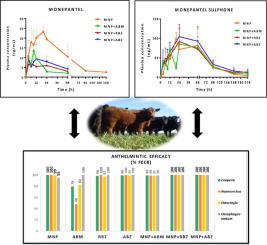International Journal for Parasitology ( IF 3.7 ) Pub Date : 2023-03-22 , DOI: 10.1016/j.ijpara.2023.02.001 Candela Canton 1 , Lucila Canton 1 , Adrian Lifschitz 1 , Maria Paula Dominguez 1 , Luis Alvarez 1 , Laura Ceballos 1 , Laura Mate 1 , Carlos Lanusse 1 , Mariana Ballent 1

|
Improvement in the use of existing anthelmintics is a high priority need for the pharmaco-parasitology research field, considering the magnitude and severity of anthelmintic resistance as an important issue in livestock production. In the work described here, monepantel (MNP) was given alone or co-administered with either macrocyclic lactone (ML) or benzimidazole (BZ) anthelmintics to calves naturally infected with ML- and BZ-resistant gastrointestinal (GI) nematodes on two different commercial cattle farms. Both pharmacokinetic (PK) and efficacy assessments were performed. On Farm A, male calves (n = 15 per group) were treated with either MNP orally (2.5 mg/kg), IVM s.c. (0.2 mg/kg), ricobendazole (RBZ) s.c. (3.75 mg/kg) or remained untreated. On Farm B, eight groups (n = 15) of male calves received treatment with either: MNP, abamectin (ABM, oral, 0.2 mg/kg), RBZ (s.c., 3.75 mg/kg), albendazole (ABZ, oral, 5 mg/kg), MNP+ABM, MNP+RBZ, MNP+ABZ (all at the above-mentioned routes and doses) or remained untreated. Seven animals from each treated group (Farm B) were randomly selected to perform the PK study. MNP and its metabolite monepantel sulphone (MNPSO2) were the main analytes recovered in plasma after HPLC analysis. The combined treatments resulted in decreased systemic exposures to MNP parent drug compared with that observed after treatment with MNP alone (P < 0.05). However, the systemic availability of the main MNP metabolite (MNPSO2) was unaffected by co-administration with either ABM, RBZ or ABZ. Efficacies of 98% (Farm A) and 99% (Farm B) demonstrated the high efficacy of MNP given alone (P < 0.05) against GI nematodes resistant to ML and BZ in cattle. While the ML (IVM, ABM) failed to control Haemonchus spp., Cooperia spp. and Ostertagia spp., MNP achieved 99% to 100% efficacy against those nematode species on both commercial farms. However, MNP alone failed to control Oesophagostomum spp. (60% efficacy) on Farm A. The co-administered treatments MNP+ABZ and MNP+RBZ reached a 100% reduction against all GI nematode genera. In conclusion, the oral treatment with MNP should be considered to deal with resistant nematode parasites in cattle. The use of MNP in combination with BZ compounds could be a valid strategy to extend its lifespan for use in cattle as well as to reverse its poor activity against Oesophagostomum spp.
中文翻译:

基于莫奈太尔的驱虫药组合可优化牛的寄生虫控制
考虑到驱虫药耐药性的严重程度和严重性是畜牧生产中的一个重要问题,改进现有驱虫药的使用是药物寄生虫学研究领域的首要任务。在此描述的工作中,莫奈太尔 (MNP) 单独给药,或与大环内酯 (ML) 或苯并咪唑 (BZ) 驱虫药共同给药,给自然感染 ML 和 BZ 抗性胃肠道 (GI) 线虫的小牛使用两种不同的商业线虫养牛场。进行药代动力学(PK)和功效评估。在农场 A,雄性犊牛(每组n = 15)接受口服 MNP(2.5 毫克/千克)、皮下 IVM(0.2 毫克/千克)、皮下注射利康达唑 (RBZ)(3.75 毫克/千克)或不进行处理。在农场 B,八组 ( n = 15) 雄性小牛接受以下治疗:MNP、阿维菌素(ABM,口服,0.2 mg/kg)、RBZ(皮下注射,3.75 mg/kg)、阿苯达唑(ABZ,口服,5 mg/kg)、MNP+ABM、MNP+RBZ、MNP+ABZ(均采用上述途径和剂量)或未治疗。从每个治疗组(农场 B)随机选择 7 只动物进行 PK 研究。MNP 及其代谢物莫奈太尔砜 (MNPSO 2 ) 是 HPLC 分析后血浆中回收的主要分析物。与单独使用 MNP 治疗后观察到的结果相比,联合治疗导致 MNP 母药的全身暴露量减少(P < 0.05)。然而,主要 MNP 代谢物 (MNPSO 2 )的全身利用率不受与 ABM、RBZ 或 ABZ 共同给药的影响。 98%(农场 A)和 99%(农场 B)的功效表明,单独给予 MNP对牛中对 ML 和 BZ 具有抗性的胃肠道线虫具有高效能(P < 0.05)。虽然 ML(IVM、ABM)未能控制Haemonchus spp.、Cooperia spp.。和Ostertagia spp.,MNP 在两个商业农场中对这些线虫物种均取得了 99% 至 100% 的功效。然而,单独使用 MNP 无法控制食道口线虫属。(60% 功效)农场 A。联合施用的处理 MNP+ABZ 和 MNP+RBZ 对所有胃肠道线虫属达到了 100% 的减少。总之,应考虑口服 MNP 治疗牛体内的耐药线虫寄生虫。MNP 与 BZ 化合物的组合使用可能是延长其在牛身上的使用寿命以及扭转其对食道口线虫属的不良活性的有效策略。


















































 京公网安备 11010802027423号
京公网安备 11010802027423号